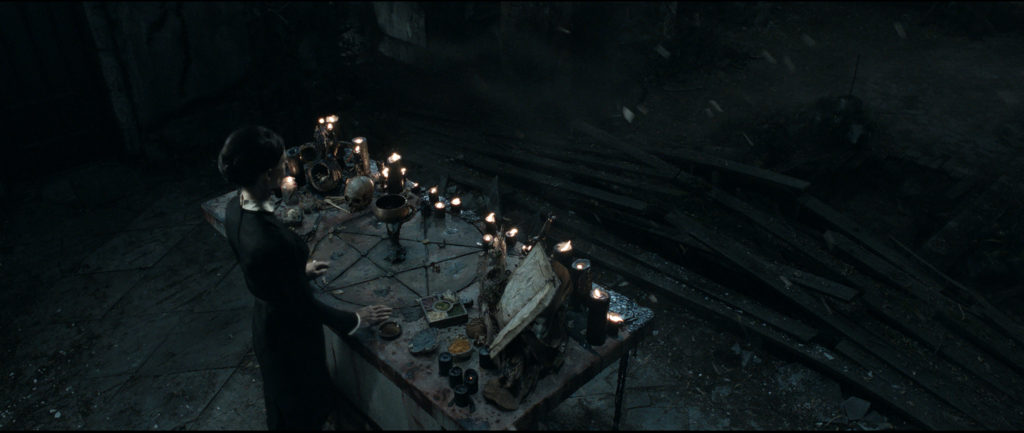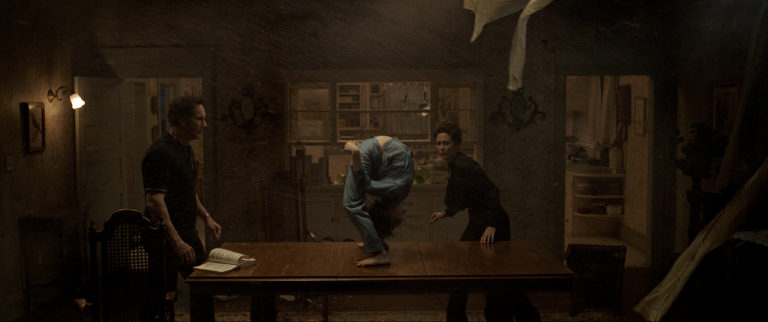The Conjuring: The Devil Made Me Do It (2021 | USA | 112 minutes | Michael Chaves)
The Conjuring series has always been a hit or miss roll of the dice with every new movie. Some are rather good, even surprisingly so, though others prove to be rather huge misfires especially as you get into some of the offshoots that struggle to justify their own existence.
At its core, there is still much to love about the idea of a horror universe that delves into different mythologies and the darkest corners of the supernatural. It is perhaps the reason why, even with not insignificant flaws, that the newest entry in the series sets itself apart as the best film thus far. The most solidly crafted and engagingly told, it is hard to see any Conjuring film getting better than The Conjuring: The Devil Made Me Do It.
The most significant reason for this is that the stakes are higher and feel more urgent than any of the other films. Even as the prior films were rated R, they could drift into feeling tame or even safe. Everything felt like it could be resolved without any bloodshed or much of a serious threat to any of the characters who would usually come out almost entirely unscathed. That is not the case here as the film is instead built around a new antagonist that, while being all too human, is the most pressing threat the characters have ever seen. It marks the first time the film has had to grapple with a malevolent force that is intentionally summoned by someone of this plane.

That force will be the focus of Patrick Wilson and Vera Farmiga who return as Ed and Lorraine Warren to deal with yet another possession. The film starts right out of the gate as the Warrens are trying to help young David Glatzel who is at risk of being completely taken over by a demonic force. Though it is alarming to his family, including his sister Debbie (Sarah Catherine Hook), it seems to be standard practice for the Warrens. You show up, do a quick little exorcism and boom they’re gone. It should be an open-and-shut case, right? Wrong.
The exorcism goes terribly awry and the Warrens will soon discover that there is more to this case than they originally suspected. When Debbie’s boyfriend Arne (Ruairi O’Connor) sacrifices himself and welcomes the demonic presence into his own body, only Ed sees it before falling unconscious from a heart attack induced by the stress of the exorcism. That means Arne will now, unbeknownst to those who love him, descend into madness until he commits an act of extreme violence while possessed. It will then fall to Warrens to exonerate him and get to the bottom of what exactly has taken hold of him.
What sets this most recent film apart from all its predecessors is how more solidly constructed and focused the story is. In The Conjuring and The Conjuring 2, a large amount of the conflict is centered around the Warrens operating disconnected from the main possession. They dawdle around before even becoming directly involved. Even once they do, they then have to prove the validity of the case in order to get sign off from the bureaucratic church who is skeptical of almost every single instance of a possession. It always felt like a forced narrative device to ensure there could be some requirement of a delay. Consistently a frustration and a huge sticking point, it undercuts what should be tense moments with boorish narrative sideswipes.

What The Conjuring: The Devil Made Me Do It does right is to avoid much of these narrative sideswipes. Even as the Warrens must prove Arne’s innocence to ensure he can avoid a criminal sentence, it never becomes caught up in the court procedures or bureaucracy of it all. Rather, they must prove to themselves what is actually happening and only then can they hope to find out what has taken place. This means going back through the history of David’s possession to find its origin point. The way director Michael Chaves constructs these scenes are more crafty and genuinely unsettling than it honestly has any business being.
Too often, the feeling of some of the prior films was that they were more focused on being like a roller coaster ride than a genuinely scary horror film. This means often bold and brash decisions in how the frightening moments were framed that all would end up letting the audience off the hook when it came to genuine scares. There still is some of that residual unwillingness to embrace a more genuinely sinister sensibility, though it is still far above where it has been in the past. It achieves this through the use of subtle sounds delicately used to build suspense in scenes that are far more patient in execution.
The standout examples of this are the scenes with Arne. When he is alone and must face the torments of his possession by himself, the nature of his isolation and hoplesses gets deeper under the skin than anything else. The fear crawls into the deepest recesses of the soul when it becomes clear how Arne is now the greatest threat to himself as the demonic force is attempting to drive him to suicide. O’Connor brings this terror to life in the hallowed etchings of his face, looking much like Bill Skarsgård from his terrifying turn in the series Castle Rock.

It also must be said that the connection between the Warrens is the most well-developed and authentically constructed to make you care about them. You see about how they met, but also who they are as well as what their future may hold. They are not immortal as they have been in the previous films where they would get beaten up and thrown all about with barely a scratch left on them. Lorraine’s ability to commune with the dead has taken more of a toll on her and Ed is struggling to recover from his near-fatal heart attack. They are more vulnerable and human than they have ever been. It is that mortality that grounds them in moments that instill the film with a great deal of gravity. .
What is remarkable is that the film, while still being one of the darkest entries in how far it is willing to go, also has the most humorous jokes that are not just earned but often clever. They are simple, visual gags told with little to no words that still elicited some chuckles from the screening. A look on a horrified lawyer’s face or a secretive wager being exchanged off to the side of the scene give the film a sense of playfulness about what it is doing. There are some unintentionally funny moments that mostly stem from bad effects with a scene at a cliffside that looked bizarre as it was clearly on a poorly used green screen. Still, these are minor hiccups.
If there was anything that seriously harms the film, it would be the ending. Without giving away more than what was alluded to earlier, the introduction of a new force of evil that stems from the actions of a malicious human being made for a fresh take on a conjuring story. It showed how the Warrens would handle facing an adversary worthy of their knowledge. The problem is that this adversary is kept too far in the shadows and is largely left unexplored. While a degree of mystery can work, withholding information to the point of underdeveloping them does not.

That means when the final credits rolled, with the customary side by side comparison to the film’s real life loose inspirations, there was a sense that much potential had been lost. There was an unshakeable feeling that the expectations being established were somewhat let down. Perhaps this is the nature of a more big budget, broad appeal horror movie that still has to wrap things up in a nice little bow. While I was certainly not expecting the film to fully commit to how dark and dour it really seemed to be leaning into, the ending does flinch ever so slightly in the face of what it could have been.
Though for how much it had going right for it, a flawed ending built off of a consistently solid foundation still ensures it stands miles above anything else the series had ever previously achieved. With that prevailing praise alone shining through, it is easy to say that The Conjuring: The Devil Made Me Do It makes for the most inventive and refreshing film thus far.
The Conjuring: The Devil Made Me Do It is available in theaters and on HBO Max starting June 4.



